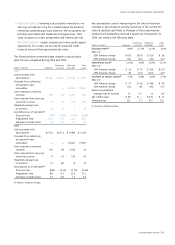GE 2006 Annual Report Download - page 106
Download and view the complete annual report
Please find page 106 of the 2006 GE annual report below. You can navigate through the pages in the report by either clicking on the pages listed below, or by using the keyword search tool below to find specific information within the annual report.
Note 28
Securitization Entities
We securitize financial assets in the ordinary course of business
to improve shareowner returns. The securitization transactions we
engage in are similar to those used by many fi nancial institutions.
Beyond improving returns, these securitization transactions serve
as funding sources for a variety of diversified lending and securities
transactions. Historically, we have used both GE-supported and
third-party entities to execute securitization transactions funded
in the commercial paper and term bond markets.
Securitized assets that are on-balance sheet include assets
consolidated upon adoption of FIN 46, Consolidation of Variable
Interest Entities (the predecessor to FIN 46R). Although we do not
control these entities, consolidation was required because we
provided a majority of the credit and liquidity support for their
activities. A majority of these entities were established to issue
asset-backed securities, using assets that were sold by us and
by third parties. These entities differ from others included in our
consolidated financial statements because the assets they hold are
legally isolated and are unavailable to us under any circumstances.
Repayment of their liabilities depends primarily on cash fl ows
generated by their assets. Because we have ceased transferring
assets to these entities, balances will decrease as the assets
repay. We refer to these entities as “consolidated, liquidating
securitization entities.”
The following table represents assets in securitization entities,
both consolidated and off-balance sheet.
December 31 (In millions) 2006 2005
Receivables secured by
Equipment $ 9,590 $12,949
Commercial real estate 11,324 13,010
Residential real estate 7,329 8,882
Other assets 14,743 12,869
Credit card receivables 12,947 10,039
Trade receivables, principally GE 3,918 3,960
Total securitized assets $59,851 $61,709
December 31 (In millions) 2006 2005
Off-balance sheet
(a)(b) $48,204 $43,805
On-balance sheet(c) 11,647 17,904
Total securitized assets $59,851 $61,709
(a) At December 31, 2006 and 2005, liquidity support amounted to $753 million
and $1,931 million, respectively. These amounts are net of $3,034 million and
$3,786 million, respectively, participated or deferred beyond one year. Credit
support amounted to $3,815 million and $5,988 million at December 31, 2006
and 2005, respectively.
(b) Liabilities for recourse obligations related to off-balance sheet assets were
$27 million and $93 million at December 31, 2006 and 2005, respectively.
(c) At December 31, 2006 and 2005, liquidity support amounted to $6,585 million
and $10,044 million, respectively. For December 31, 2005, this amount is net of
$138 million participated or deferred beyond one year. No amounts have been
participated or deferred beyond one year at December 31, 2006. Credit support
amounted to $2,926 million and $4,780 million at December 31, 2006 and 2005,
respectively.
The portfolio of financing receivables consisted of loans and
financing lease receivables secured by equipment, commercial
and residential real estate and other assets; credit card receivables;
and trade receivables. Examples of these assets include loans
and leases on manufacturing and transportation equipment,
loans on commercial property, commercial loans, and balances
of high credit quality accounts from sales of a broad range of
products and services to a diversifi ed customer base.
Assets in consolidated, liquidating securitization entities are
shown in the following captions in the Statement of Financial
Position.
December 31 (In millions) 2006 2005
Financing receivables — net (note 13) $11,509 $16,615
Other assets 138 1,289
Total $11,647 $17,904
Off-balance sheet arrangements
We engage in off-balance sheet securitization transactions with
third-party entities and use public market term securitizations.
As discussed above, assets in off-balance sheet securitization
entities amounted to $48.2 billion and $43.8 billion at December 31,
2006 and 2005, respectively. Gross securitization gains amounted
to $1,199 million in 2006 compared with $939 million in 2005
and $1,195 million in 2004.
Amounts recognized in our financial statements related to
sales to off-balance sheet securitization entities are as follows:
December 31 (In millions) 2006 2005
Retained interests $4,760 $4,515
Servicing assets 9 29
Recourse liability (27) (93)
Total $4,742 $4,451
• RETAINED INTERESTS. When we securitize receivables, we
determine fair value of retained interests based on discounted
cash flow models that incorporate, among other things,
assumptions about loan pool credit losses, prepayment
speeds and discount rates. These assumptions are based on
our experience, market trends and anticipated performance
related to the particular assets securitized. We classify
retained interests in securitized receivables as investment
securities and mark them to fair value each reporting period,
updating our models for current assumptions. These assets
decrease as cash is received in payment. When the carrying
amounts exceed fair value, we evaluate whether the unrealized
loss is other than temporary and, if so, record any indicated
loss in earnings currently.
104 ge 2006 annual report
























